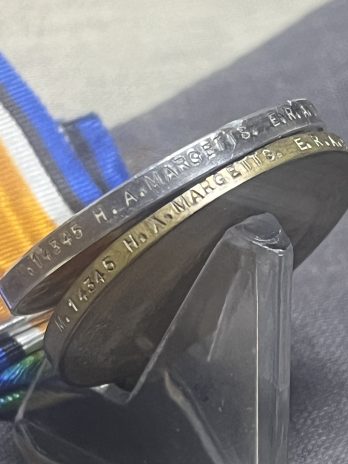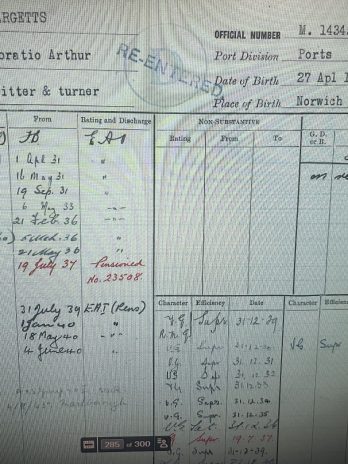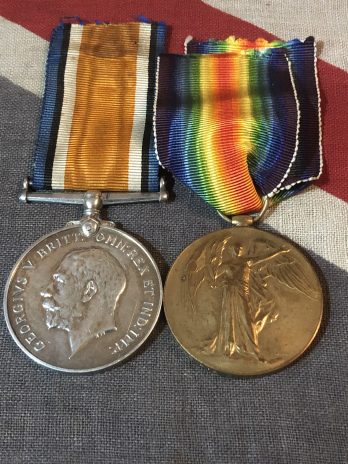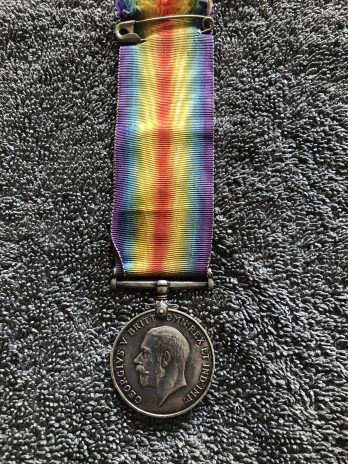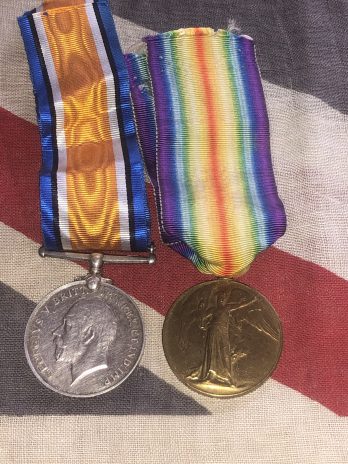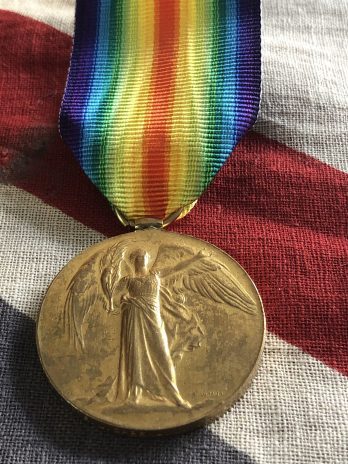Correctly named M14345 HA Margetts ERA3 RN
Horatio Arthur Margetts was born to Stephen and Florence in Norfolk in 1894.
In 1911, we see him living with his family at 97 Unthank Road in Norwich and is noted as working as an electrical engineer.
He enlisted into the Royal Navy in 1915 where his occupation is noted as that of a fitter/turner.
He served the majority of his wartime service on HMS Maidstone, a Submarine depot ship. Primarily based at Harwich, in 1916 was the depot ship for the 9th Submarine Flotilla, prior to this, she was the Depot Ship for the 8th Submarine Flotilla.
He was to move around some bases until the end of the War including being based at Portland.
We see in 1921, he becomes a Freemason and is recorded as being an electrician at Grant Lodge, Galle, Ceylon.
After the War, he remained in service and went on to earn his Long Service Good Conduct Medal in 1930 while aboard HMS Witch (HMS Highflyer).
He served up until July 1937 and pensioned. We see he then for a time worked for the Post Office.
It is worth mentioning that he did serve aboard the ‘Mighty’ HMS Hood from May 1933 until February 1936. In January 1935, HMS Hood was struck by HMS Renown.
Captain Thomas Tower replaced Captain Binney on 30 August 1933. Her secondary and antiaircraft fire-control directors were rearranged during another quick refit between 1 August and 5 September 1934.[49]
While en route to Gibraltar for a Mediterranean cruise, Hood was rammed in the port side quarterdeck by the battlecruiser Renown on 23 January 1935. The damage to Hood was limited to her left outer propeller and an 18-inch dent, although some hull plates were knocked loose from the impact. Temporary repairs were made at Gibraltar before the ship sailed to Portsmouth for permanent repairs between February and May 1935. The captains of both ships were court-martialled, as was the squadron commander, Rear-Admiral Sidney Bailey. Tower and Bailey were acquitted, but Renown’s Captain Sawbridge was relieved of command. The Admiralty dissented from the verdict, reinstated Sawbridge, and criticised Bailey for ambiguous signals during the manoeuvre.
With War looming, he was recalled to service in July 1939. With Horatio serving, we find his wife Lily living at 47 Hatch Road, Croydon in 1939.
From January 1940, he was serving aboard HMS Effingham.
When the Second World War began in September 1939, Effingham was assigned to the Northern Patrol, but severe engine problems caused her to spend most of the next six months under repair. In between dockyard visits, the ship ferried a load of gold bullion to Canada and was briefly assigned to the North America and West Indies Station. After a lengthy refit at the beginning of 1940, Effingham supported Allied troops during the Norwegian Campaign, mostly bombarding German positions and providing naval gunfire support to troops ashore. While ferrying troops and supplies to Bodø on 18 May, the ship struck a shoal due to a navigational error and sank in shallow water. Her crew was evacuated without loss and the cruiser destroyed by a pair of torpedoes from an accompanying destroyer. Her wreck was salvaged after the war with only some minor wreckage remaining. Rumours abound that the ships navigator was a Nazi sympathiser.
At 0400 hours, HMS Effingham departed Harstad, Norway with 1,020 troops, 10 Bren Gun Carriers, and 130 tons of supplies on board for Bodø, Norway, which was roughly 80 miles or 130 kilometers to the south. She was under the command of Captain J. M. Howson, and the group she belonged to was under the overall command of Rear-Admiral G. Vivian in HMS Coventry. En route, at 1948 hours, she hit the southern edge of the Faksen Shoal and slowly settled on even keel. Captain Howson attempted to beach the ship to save the lives of the over 1,000 passengers on board; although Rear-Admiral Vivian countermanned the order, fearing that beaching the ship would lead to German capture, steering power was lost shortly after, rendering Howson unable to follow his superior’s order. The ship drifted in the mild wind, and an attempt to tow was made. Ultimately, she was grounded several miles off Bodø. All of the passenger and crew were rescued by other ships in the group. As a German aircraft appeared on the horizon (which was chased off by two Skua aircraft from HMS Ark Royal), Vivian feared that the Germans would react soon, thus HMS Effingham was torpedoed and sunk in 30 feet of water by destroyer HMS Matabele at 0800 hours on 18 May. Three days later, the British Admiralty released an official statement noting that the sinking was caused by a collision with an uncharted rock, which was untrue, and as a result of this statement Rear Admiral Vivian, who led the group into the shoal area at a high speed, became blameless for the sinking.
The Norwegian campaign (8 April –10 June 1940) involved the attempt by Allied forces to defend northern Norway coupled with the resistance of the Norwegian military to the country’s invasion by Nazi Germany in World War II.
Planned as Operation Wilfred and Plan R 4, while the German attack was feared but had not yet happened, the battlecruiser HMS Renown set out from Scapa Flow for Vestfjorden with twelve destroyers on 4 April. The Royal Navy and the Kriegsmarine met at the first and second naval battles of Narvik on 10 and 13 April, and British forces conducted the Åndalsnes landings on 13 April. The main strategic reason for Germany to invade Norway was to seize the port of Narvik and guarantee the delivery of iron ore needed for German steel production.
The campaign was fought until 10 June 1940 and saw the escape of King Haakon VII and Crown Prince Olav to the United Kingdom. A British, French and Polish expeditionary force of 38,000 troops landed in the north. It had moderate success but made a rapid strategic retreat after the Battle of France began on 14 May. The Norwegian government then went into exile in London. The campaign ended with the occupation of the entirety of Norway by Germany but elements of the Norwegian military escaped and fought on overseas.
Horatio was to be based on HMS Victory II directly after the loss of HMS Effingham.
Records show him to have married Lily O Leyman in Brighton in 1943.
He was released from service in September 1945
Horatio died in 1972.
Unfortunately a broken group missing his Long Service Medal with 1939-1945 Star and WWII war and Defence Medals.
Both medals have original silk ribbons.






